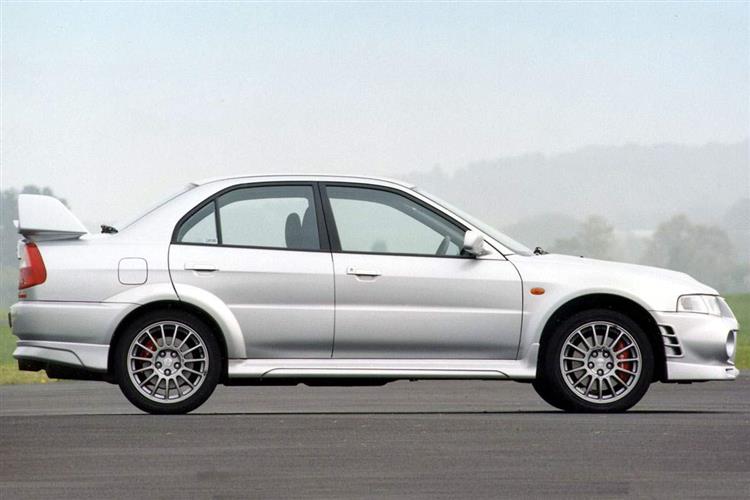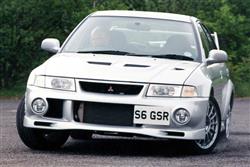PRIVATE LANCER (some text hidden) --NONE--
BY ANDY ENRIGHT
Introductionword count: 114
The Mitsubishi Lancer Evolution VI is one of the most extreme cars available for purchase, and one of the closest things to a top-flight competition car on general release. Despite being based on the prosaic Carisma saloon, the Evo VI (as it is usually called) is a road-going version of Mitsubishi's World Rally Championship winning car, and even in its less extreme guises never feels anything but ridiculously quick. A used Evo VI is going to appeal to a small sector of drivers who appreciate warping speed and otherworldly handling. With a wide variety of limited edition variants, grey imports, official imports and ex-rally cars there's plenty for the buyer to look out for.
Modelsword count: 16
Models Covered: (4 dr saloon 2.0 petrol [GSR, RS, RS II, RSX, Tommi Makinen Edition, Extreme])
Historyword count: 396
The Evolution series was first launched in Japan in 1992 with the Lancer GSR Evolution. Built to allow Mitsubishi to compete in the World Rally Championship, the first Evo pioneered the formula that all subsequent cars would follow - a turbocharged 2.0-litre engine, big spoilers and lightweight interior. The Evo II and III were launched respectively in 1993 and 1995, with the Evolution IV in 1996. The first of the more modern Mitsubishi Carisma based models was the Lancer Evo V, which made its world debut at the Tokyo Show in October 1997. None of these models were ever officially imported to the UK, and it was only during the late nineties when the British public started to appreciate Japanese sports cars such as the Subaru Impreza and Nissan Skyline that demand for Lancer Evo models in the UK really took off. An outlet of Ralliart, Mitsubishi's rally preparation arm, sold the Evo VI from early 1998, but it wasn't until May 1999 that Mitsubishi officially launched the car in the UK with the development of Ralliart UK, a new company offering closer ties with the UK importer. Between early 1998 and May 1999, a number of 'standard' GSR models, and lightweight RS and RS II models were sold from the Dudley dealership. When Ralliart UK was formed, the range was rationalised. The RS II received some slight trim changes and became the cut-price RSX, produced in a limited batch of 30 cars. The standard GSR model continued, and the racier Zero Fighter model, which was a cult car in Japan, was rebranded for sale in the UK as the range-topping 340bhp Extreme. This slightly less inflammatory designation hadn't stopped some folk importing Zero Fighter models from Japan or ordering the kit to transform their GSR up to Zero Fighter specification. The limited-run Extreme sold out during 1999, leaving the way clear for a new range-topping variant to be developed. The Tommi Makinen edition was subsequently launched in May 2000 to commemorate the Finnish rally ace's fourth World Rally Championship title. The car was available in four colours or with a special colouring pack with Ralliart stripes and decals. For those who wanted to be noticed, this was definitely the Evo to have. Subsequent Evo VI and Evo VIII models toned down the Evo VI's wild exterior and the VI still has a genuine cult following.
What You Getword count: 374
The Lancer Evo VI offers extreme performance and barely credible reserves of grip, yet it's not a particularly intimidating car to drive. Being based on a humble Carisma means that you get four doors, a big boot, an upright seating position and pretty good space for rear passengers. When you look in the mirror you'll see a lot of rear wing, but with this car perhaps more than any other, form is definitely following function. Some may feel that the Evo VI is chunky, aggressive and purposeful, while most will think it plain ugly. The variants all offer varying degrees of unreality when you plant your right foot. The original and, many would argue the best is the Evo VI GSR. This is probably the variant most suited to everyday driving, with 280bhp on tap, climate controlled air conditioning, anti-lock brakes and Active Yaw Control. This system is a stability control device to prevent excessive differences in wheelspin or deviations from the intended route when cornering. About 85% of all Evo VI models sold were in GSR trim. The Evo VI RS and RS II models were lightweight versions of the GSR without anti-lock brakes, the clever Active Yaw Control system or any form of warranty, Ralliart reckoning that these models would, by and large, go straight into the hands of Group N rally contestants. Nonetheless, there were still a handful sold to buyers looking to use them as road and track cars. When Ralliart UK was launched in 1999, the RS II was rebranded as the RSX, and gained better Recaro seats and higher quality interior trim. Only 30 were built. The true Evo enthusiast is going to look for one of the rare Tommi Makinen editions, or the rarer still Extreme. The Tommi Makinen offered bigger Brembo brakes, a restyled front spoiler and bumper, 'Makinen' monogrammed interior trim, inverted shock absorbers, modified turbocharger and the option of a special colouring package. The monstrous Extreme was the UK version of the Japanese Evo VI Zero Fighter and came with lowered suspension, a remapped engine control unit and a carbon fibre interior. With 340bhp on tap, this is one model which, unlike the Carisma upon which it's based, certainly lives up to its name.
To see the full road test text contact us on 0330 0020 227
Pictures (high res disabled)


|
Scoring (subset of scores)
Category: Sporting Cars
| Performance | |
| Handling | |
| Comfort | |
| Space | |
| Styling, Build, Value, Equipment, Depreciation, Handling, Insurance and Total scores are available with our full data feed. | |



